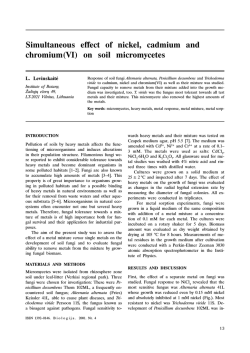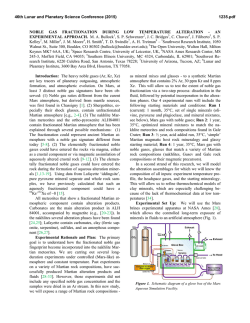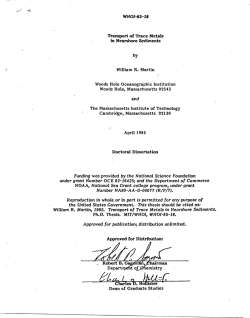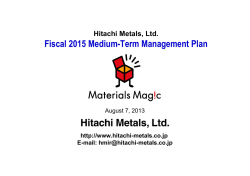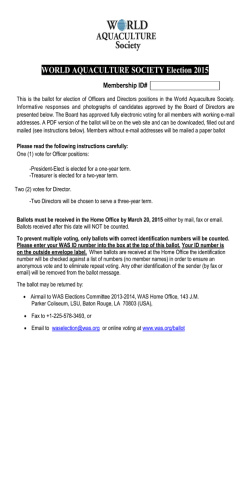
Bioaccumulation of heavy metals in noble crayfish ()IJ=?KI =IJ=?KI L
Bioaccumulation of heavy metals in noble crayfish (Astacus astacus L.) tissues under aquaculture conditions Bioaccumulation of heavy metals in noble crayfish ()IJ=?KI =IJ=?KI L.) tissues under aquaculture conditions Guoda Mackevièienë Institute of Ecology, Akademijos 2, LT-2600 Vilnius, Lithuania E-mail: [email protected]. The noble crayfish Astacus astacus L. is a valuable and protected crayfish species and the only native and dominant species in Lithuania. In a polluted environment crayfish are able to accumulate a considerable amount of heavy metals in organs and tissues. The aim of the present work was to assess their nutritive value in aquaculture conditions according to parameters of ecological cleanness. The data of toxicological analysis, obtained by the method of atomic absorption, revealed that the levels of bioaccumulation of heavy metals are different in various tissues of noble crayfish and are generally arranged in the following decreasing order: Mn > Zn > Cu > Ni > Cr > > Pb > Cd. The mean values of heavy metals were determined in crayfish muscles: Zn 4.65 µg/g; Cu 1.22 µg/g; Mn 5.56 µg/g; Ni 0.17 µg/g; Cr 0.06 µg/g; Pb 0.05 µg/g; Cd 0.01 µg/g wet weight. These values comply with the standards applied in fishery. Key words: noble crayfish, heavy metals, bioaccumulation INTRODUCTION Freshwater crayfish, the largest and most valuable invertebrates of Lithuanian waterbodies, feed on detritus, zoobenthic animals and aquatic plants. Being omnivorous, crayfish play an important role in the trophic chain of benthic communities in lakes and rivers and contribute to the regulation of freshwater ecosystems [8]. Freshwater crayfish species are considered to be biological indicators of clean water because of their relatively lower locomotory activity in comparison with fish [5, 12]. Generally, crustaceans accumulate some heavy metals directly proportional to the increase in bioavailability from water and trophic chains [11]. In polluted environment crayfish are able to accumulate a considerable amount of heavy metals in their tissues and to excrete some of them [3]. Environmental xenobiotics are accumulated through nutrient links and direct absorption mostly in the digestive tract, hepatopancreas, kidneys and gills [2]. The concentrations of heavy metals in the crayfish body are regulated by metal-binding proteins, hepatic metallothioneins to a constant level until metal bioavailability exceeds the higher threshold, when the regulation breaks down and net accumulation begins [10]. The tolerance of crayfish species to anthropogenic ISSN 02357224. E k o l o g i j a pollution is different and depends on the adaptive plasticity which is species-specific [12]. If crayfish from a contaminated area are consumed in large quantities they could cause adverse health consequences. It is important to have knowledge on heavy metal levels in the tissues of crayfish used for food. The aim of the present work was to investigate the accumulation level of heavy metals in the organism of native noble crayfish A. astacus, which is sensitive to environmental changes, and to assess their nutritive value under semi-natural culture conditions according to the parameters of ecological cleanness. The accumulation levels of heavy metals in the noble crayfish tissues under aquaculture conditions were not examined. MATERIAL AND METHODS Ecotoxicological investigations of noble crayfish A. astacus were started in 1998. Adult crayfish trapped from Lake Gailintas were transferred to the first noble aquaculture centre at Simnas Fishery Station (Alytus distr.) and kept in tanks in flow-through water system. Marketing size males (n = 10) of similar body mass (3545 g), total body length (9 10 cm) and of same stage (C4) of intermoult cycle were dissected and samples of separate tissues (Vilnius). 2002. Nr. 2 79 Guoda Mackevièienë (muscles, hepatopancreas, digestive tract, carapace) were frozen. Heavy metal (Mn, Zn, Cu, Cr, Ni, Cd, Pb) concentrations were determined in crayfish tissues by electrothermal atomic absorption spectrometry with AAS-30 (Carl Zeiss Jena) and AA-25 Plus (Varian) spectrophotometers with a graphite furnace in the heavy level [1]. The samples digest for metal analyses was prepared by heating with an Apion dry mode mineraliser. The mineralization was conducted under atmospheric pressure. The principle of the mineralization was original, wholly universal and proceeded by heating a superoxidative gas mixture in a container with a sample to a chosen temperature within the range of 300400 °C. The oxidative gas mixture consisted of oxygen, nitrogen oxide and ozone and was prepared in the device by combustion of ammonia and by ozonation. As a by-product, chemically pure nitric acid was formed, which can be used after distillation for dissolving the samples after mineralization. Concentrations of heavy metals in noble crayfish tissues were calculated in µg/g wet weight. Numerical data were processed by standard statistical methods applying Students t test. ters of water were: O2 was 810 mg/l; pH was 7.35; total hardness 187.2 mg/l as CaCO3; Ca2+ was 52.1 mg/l; alkalinity was 244.1 mg/l as HCO3. The results of heavy metal concentration assessments in water samples from the hatchery were compared with those of water quality standards (maximum permissible concentrations (MPC) applied in fishery (Table 1). The concentration of Mn exceeded twice the MPC level. In most Lithuanian waters, high concentrations of Mn and Fe are found, so it could be due to the natural background. The heavy metal accumulation level by various tissues of noble crayfish is shown in Table 2. All data presented in this table are mean of triplicate samples. The data obtained showed that noble crayfish accumulated heavy metals generally in the following sequence: Mn > Zn > Cu > Ni > Cr > > Pb > Cd. Metal accumulation levels in various tissues of crayfish were different (Figs. 1 and 2) and are arranged in a decreasing order: Zn hepatopancreas > exoskeleton > digestive tract > muscles; Cu and Ni exoskeleton > hepatopancreas > muscles > digestive tract; Mn and Cr exoskeleton > digestive tract > hepatopancreas > muscles; Pb and Cd hepatopancreas > digestive tract > > muscles > exoskeleton. In the abdominal muscles of noble crayfish the mean values of heavy metals were: Mn 5.56 µg/g; Zn 4.65 µg/g; Cu 1.22 µg/g; Cr 0.06 µg/g; RESULTS Noble crayfish were kept in flow-through hatchery tanks supplied with Lake Dusia (Alytus distr.) water of high quality. Main physico-chemical parame- Table 1. Concentrations of heavy metals (µ µg/l) in flow-through water system in Simnas noble crayfish aquaculture centre (Alytus distr.) Tanks of hatchery MAC*, µg/l Zn Cu Cr Ni 7.54 10.0 1.18 1.0 0.34 5.0 0.36 10.0 Pb 4.22 100.0 Cd Mn Hg Fe 0.04 5.0 23.4 10.0 0 0.1 94.0 100.0 * Maximum permissible concentration (MPC) of metals for fishery purposes. Table 2. Average values and standard deviations (SD) of some heavy metals in organs and tissues of noble crayfish )IJ=?KI =IJ=?KI L. collected from Simnas aquaculture centre (Alytus distr.) Concentrations of heavy metals, µg/g wet weight Organs and tissues Muscles Exoskeleton Hepatopancreas Digestive tract 80 Mn Zn Cu Cr Ni Pb Cd 5.56 (±3.87) 118.00 (±11.00) 56.00 (±8.81) 76.26 (±8.61) 4.65 (±0.07) 6.99 (±0.51) 9.88 (±1.56) 6.08 (±0.45) 1.22 (±0.25) 1.93 (±0.29) 1.38 (±0.44) 0.97 (±0.11) 0.06 (±0.01) 0.11 (±0.01) 0.07 (±0.01) 0.10 (±0.01) 0.17 (±0.06) 0.82 (±0.36) 0.43 (±0.20) 0.16 (±0.00) 0.05 (±0.00) 0.04 (±0.00) 0.08 (±0.00) 0.06 (±0.01) 0.01 (±0.00) not found 0.003 (±0.01) 0.01 (±0.00) Bioaccumulation of heavy metals in noble crayfish (Astacus astacus L.) tissues under aquaculture conditions 3,0 Cr Ni Cu 2,5 2,0 1,5 1,0 0,5 0,0 Hepatopancreas Digestive tract Muscles Exoskeleton Fig. 1. Accumulation of copper, chromium and nickel (µg/ g wet weight) in organs and tissues of adult males of noble crayfish Astacus astacus L. 40 Zn 20 Mn 00 80 60 40 20 0 Hepatopancreas Digestive tract Muscles Exoskeleton Fig. 2. Accumulation of zinc and manganese (µg/g wet weight) in organs and tissues of adult males of noble crayfish Astacus astacus L. Ni 0.17 µg/g; Pb 0.05 µg/g and Cd 0.01 µg/g (Table 2). These values not exceed the maximum permissible level of copper (2050 µg/g) and Cd (0.3 µg/g wet weight) in soft tissues of crayfish applied in fishery [12, 7]. Similar results were obtained in the muscles of acclimatized in Lithuania American signal crayfish Pacifastacus leniusculus Dana trapped in natural populations: copper 1.69 µg/g; nickel 1.15 µg/g; chromium 0.12 µg/g wet weight [6]. Thus, according our data noble crayfish reared under aquaculture conditions in the Simnas Fishery Station can be suitable for consumption as food. DISCUSSION Benthic invertebrates, crayfish among them, are in direct contact with heavy metals both of natural and anthropogenic origin. The discharge of metals by industry represents a serious water pollution problem due to the toxic properties of these elements and their adverse effects on water quality. Crayfish under natural conditions are impacted not by single heavy metals, but by the multicomponent pollution containing a mixture of metals, organic substances and other xenobiotics. Zinc, copper and chromium constitute essential heavy metals in crayfish, having many biological effects, but also known as toxicants. Nickel, cadmium and lead are generally thought to be biologically non-essential heavy metals, which enter the animal by following the same biochemical pathways as essential elements [2]. Zn and Cu appear to diffuse passively (probably as a soluble complex) the gradients created by adsorption of membrane surfaces and are bound by blood proteins metallothioneins [3]. Carbonell and Tarazona [4] concluded that different tissues of aquatic animals provide and/or synthesize nonexchangeable binding sites resulting in different accumulation levels. Copper has also been shown to be a regulated metal in freshwater decapods. This may be related to the essential biochemical role of this metal in the production of the respiratory protein, haemocyanin [3, 10]. Chromium is involved in normal carbohydrate metabolism. According to Nagvi et al. [9], crayfish accumulate heavy metals rapidly and can be used for testing metal bioavailability of polluted fresh waters, but not in a long-term monitoring program. The presence of substantial concentrations of Cu, Cr, Ni and Mn in the exoskeleton and hepatopancreas might indicate that these tissues are involved in the excretion of these metals [2]. The highest accumulation level of Pb and Cd found in the digestive system of noble crayfish reflected the storage capacity for heavy metals. According to Viikinkoski et al. [12], cadmium content in abdominal muscles of noble crayfish A. astacus trapped in northwest Finland waterbodies were low so the muscle tissues were edible. Crayfish contained more cadmium in fresh hepatopancreas (0.84 µg/g) than Finnish legislation allows in common foodstuff (0.3 µg/g wet weight). Vogt & Quinitio [13] suggested that crustacean hepatopancreas combines various functions of the vertebrate liver, pancreas and intestines. Digestive gland is the prime site of nutrient absorption, metal storage and detoxication. F-cells of hepatopancreas of Decapoda have been regarded as the site of detoxication of certain metals, which are stored in supranuclear vacuole [13]. The first data of toxicological investigations of noble crayfish reared under aquaculture conditions revealed the following general relationship among metal concentrations in tissues of native crayfish species: Mn > Zn > Cu > Ni > Cr > Pb > Cd. Bagatto and Alikhan [2] determined a similar relationship among the crayfish Orconectes virilis tissue metal concentrations: Cu > Ni > Cd. According to our data, noble crayfish from the Simnas Aquaculture Centre would be suitable for commercial sales on the basis of low heavy metal content in soft tissues. 81 Guoda Mackevièienë CONCLUSIONS Accumulation levels of physiologically important metals (Zn, Cu, Cr, Mn) and non-essential elements (Ni, Cd, Pb) are different in the examined tissues of noble crayfish reared under aquaculture conditions. In general, the highest content of Zn was detected in the hepatopancreas, which is a prime site for metal storage and detoxication, and the lowest content was found in the abdominal muscles. The highest Mn concentration was found in the exoskeleton, hard body tissue, has followed by the digestive tract and hepatopancreas. The carapace and hepatopancreas contain a relatively higher amount of Cu compared to muscles and the digestive tract. The presence of substantial concentration of Ni and Cr in the carapace might indicate that this tissue was involved in the absorption and excretion of these metals. There was no differences in very low concentrations of Pb and Cd in the examined tissues. The general relationship among the crayfish tissue metal concentrations under Simnas hatchery conditions was as follows: manganese (Mn) > zinc(Zn) > > copper (Cu) > nickel (Ni) > chromium (Cr) > > lead (Pb) > cadmium (Cd). Based on the International Regulations for metal residues in crayfish, we concluded that concentrations of some heavy metals determined in soft tissues of the animals studied did not exceed the maximum permitted level and therefore crayfish were in good condition for culture purposes. 6. Mackevièienë G. Some characteristics of metabolism of signal crayfish Pacifastacus leniusculus Dana acclimatised in Lithuania. ÊF-Rapport No. 26/1998. Proceedings of Nordic-Baltic Workshop on Freshwater Crayfish Research and Management. Lillehammer, 1999. P. 221238. 7. Maranhao P., Marques J. C., Madeira V. Copper concentrations in soft tissues of the red swamp crayfish Procambarus clarkii (Girard, 1852), after exposure to a range of dissolved copper concentrations. Freshwater Crayfish. 1995. Vol. 10. P. 282286. 8. Momot W. T. Redefining the role of crayfish in aquatic ecosystem. Reviews in Fisheries Science. 1995. No. 3. P. 3363. 9. Nagvi S. M., Devalraju N., Nagvi H. Copper bioaccumulation and depuration by Red Swamp crayfish, Procambarus clarkii; Bull. Environ. Contam. Toxicol. 1998. Vol. 61. P. 6571. 10. Rainbow S., White S. L. Comparative strategies of heavy metal accumulation by crustaceans: zinc, copper and cadmium in decapod, an amphipod and a barnacle. Hydrobiologia. 1989. Vol. 174. P. 245262. 11. Rainbow P. S., Phillips D. J., Depledge M. H. The significance of heavy metal concentrations in marine invertebrates. A need for laboratory investigation of accumulation strategies. Mar. Pollut. Bull. 1990. Vol. 21. P. 321324. 12. Viikinkoski T., Henttonen P., Matinvesi J., Könönen H. L., Suntioinen S. The physiological condition and ability of noble crayfish (Astacus astacus L.) in warm waste water of a steel works in Northwest Finland. Freshwater Crayfish. 1995. Vol. 10. P. 304321. 13. Vogt G., Quinitio E. M. Accumulation and excretion of metal granules in the prawn, Penaeus monodon, exposed to water-borne copper, lead, iron and calcium. Aquat. Toxicol. 1994. Vol. 28. P. 223241. ACKNOWLEDGEMENTS Guoda Mackevièienë The author is grateful to N. Ðtriupkuvienë, R. Kreslauskaitë and J. Vitkienë (Laboratory of Chemical and Physical Methods, Ministry of Protection, Lithuania) for analysis of heavy metals in water and crayfish tissue samples. SUNKIØJØ METALØ BIOAKUMULIACIJA PLAÈIAÞNYPLIØ VËÞIØ ()56)+75 )56)+75 L.) AUDINIUOSE References 1. Analytical Methods for Graphite Tube Atomisers (ed. E. Rotery) Mulgrave, Victoria, Australia, 1988. 191 pp. 2. Bagatto G., Alikhan M. A. Copper, cadmium, and nickel accumulation in crayfish populations near copper-nickel smelters at Sudbury, Ontario, Canada. Bulletin of Environmental Contamination and Toxicology. 1987. Vol. 38. P. 540545. 3. Bryan G. W. Concentration of zinc and copper in the tissues of decapod crustaceans. J. Mar. Biol. 1968. Vol. 48. P. 303321. 4. Carbonell G., Tarazona J. V. Toxicokinetics of Cu. Aquat. Toxicol. 1994. Vol. 29. P. 213221. 5. Chambers M. G. The effect of acute cadmium toxicity on marron Cherax tenuimanus (Smith, 1912) (Family Parastacidae). Freshwater Crayfish. 1995. No. 10. P. 209220. 82 Santrauka Atominës absorbcijos metodu nustatytos sunkiøjø metalø mangano, cinko, vario, chromo, nikelio, ðvino ir kadmio bioakumuliacijos vertës subrendusiø plaèiaþnypliø vëþiø patinø raumenyse, virðkinimo sistemoje ir kiaute. Pagal pusiau gamtiná akvakultûroje akumuliacijos lygmená vëþiø kiaute ir minkðtuosiuose audiniuose sunkieji metalai pasiskirsto ðia maþëjanèia tvarka: Mn > Zn > Cu > Ni > Cr > Pb > > Cd. Cinko, kuris yra nepakeièiamas mikroelementas, daugiausia sukaupë vëþiø virðkinimo liauka (hepatopancreas), atliekanti svarbø fermentø sekrecijos, medþiagø hidrolizës, deponavimo ir detoksikacijos vaidmená. Vëþiø karapakso mëginiuose nustatytos didþiausios Mn, Cu, Cr ir Ni koncentracijos, o tai susijæ su aktyviu metalø transportu ir ekskrecija per kûno pavirðiø. Toksiðkiausiø metalø Pb ir Cd kiekiai tirtuose audiniuose patikimai nesiskyrë, jø vertës nereikðmingos. Tyrimais nustatytos vidutinës sunkiøjø metalø bioakumuliacijos vertës buvo maþesnës uþ galiojanèias tarptautines normas þuvininkystëje pagal didþiausios leistinos koncentracijos standartus.
© Copyright 2025
